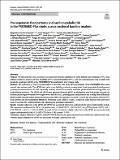Por favor, use este identificador para citar o enlazar a este item:
http://hdl.handle.net/10261/289797COMPARTIR / EXPORTAR:
 SHARE SHARE
 CORE
BASE CORE
BASE
|
|
| Visualizar otros formatos: MARC | Dublin Core | RDF | ORE | MODS | METS | DIDL | DATACITE | |

| Título: | Pro-vegetarian food patterns and cardiometabolic risk in the PREDIMED-Plus study: a cross-sectional baseline analysis |
Autor: | Oncina-Canovas, Alejandro; Vioque, Jesús; González-Palacios, Sandra; Martínez-González, Miguel Ángel; Salas-Salvadó, Jordi; Corella, Dolores; Zomeño Fajardo, Maria Dolores; Martínez, J. A.; Alonso-Gómez, Ángel M.; Wärnberg, Julia CSIC ORCID; Romaguera, Dora; López-Miranda, José; Estruch, Ramón; Bernal-López, María Rosa; Lapetra, José; Serra-Majem, Luís; Bueno-Cavanillas, Aurora; Tur, Josep A.; Martín-Sánchez, Vicente; Pintó, Xavier; Delgado-Rodríguez, Miguel; Matía-Martín, Pilar; Vidal, Josep; Vázquez, Clotilde; Daimiel, Lidia; Ros, Emilio; Toledo, Estefanía; Babio, Nancy; Sorlí, Jose V.; Schröder, Helmut; Zulet, M. Ángeles; Sorto-Sánchez, Carolina2; Barón-López, Francisco Javier; Compañ-Gabucio, Laura; Morey, Marga; Garcia-Rios, Antonio; Casas, Rosa; Gómez-Pérez, Ana María; Santos-Lozano, José Manuel; Vázquez-Ruiz, Zenaida; Nishi, Stephanie K.; Asensio, Eva M.; Soldevila, Núria; Abete, Itziar; Goicolea-Güemez, Leire; Buil-Cosiales, Pilar; García-Gavilán, Jesús F.; Canals, Erik; Torres-Collado, Laura; García de la Hera, Manuela | Palabras clave: | Dietary food patterns Cardiometabolic risk Metabolic syndrome Pro-vegetarian |
Fecha de publicación: | 2022 | Editor: | Springer Nature | Citación: | European Journal of Nutrition 61: 357-372 (2022) | Resumen: | [Purpose]: We explored the cross-sectional association between the adherence to three different provegetarian (PVG) food patterns defined as general (gPVG), healthful (hPVG) and unhealthful (uPVG), and the cardiometabolic risk in adults with metabolic syndrome (MetS) of the PREDIMED-Plus randomized intervention study. [Methods]: We performed a cross-sectional analysis of baseline data from 6439 participants of the PREDIMED-Plus randomized intervention study. The gPVG food pattern was built by positively scoring plant foods (vegetables/fruits/legumes/grains/potatoes/nuts/olive oil) and negatively scoring, animal foods (meat and meat products/animal fats/eggs/fish and seafood/dairy products). The hPVG and uPVG were generated from the gPVG by adding four new food groups (tea and coffee/fruit juices/sugar-sweetened beverages/sweets and desserts), splitting grains and potatoes and scoring them differently. Multivariable-adjusted robust linear regression using MM-type estimator was used to assess the association between PVG food patterns and the standardized Metabolic Syndrome score (MetS z-score), a composed index that has been previously used to ascertain the cardiometabolic risk, adjusting for potential confounders. [Results]: A higher adherence to the gPVG and hPVG was associated with lower cardiometabolic risk in multivariable models. The regression coefficients for 5th vs. 1st quintile were − 0.16 (95% CI: − 0.33 to 0.01) for gPVG (p trend: 0.015), and − 0.23 (95% CI: − 0.41 to − 0.05) for hPVG (p trend: 0.016). In contrast, a higher adherence to the uPVG was associated with higher cardiometabolic risk, 0.21 (95% CI: 0.04 to 0.38) (p trend: 0.019). [Conclusion]: Higher adherence to gPVG and hPVG food patterns was generally associated with lower cardiovascular risk, whereas higher adherence to uPVG was associated to higher cardiovascular risk. | Versión del editor: | http://dx.doi.org/10.1007/s00394-021-02647-4 | URI: | http://hdl.handle.net/10261/289797 | DOI: | 10.1007/s00394-021-02647-4 | Identificadores: | doi: 10.1007/s00394-021-02647-4 issn: 1436-6207 e-issn: 1436-6215 |
| Aparece en las colecciones: | (IIBM) Artículos |
Ficheros en este ítem:
| Fichero | Descripción | Tamaño | Formato | |
|---|---|---|---|---|
| Pro-vegetarian food patterns and cardiometabolic_Oncina_PV_Art2022.pdf | 787,4 kB | Adobe PDF |  Visualizar/Abrir |
CORE Recommender
SCOPUSTM
Citations
13
checked on 18-abr-2024
WEB OF SCIENCETM
Citations
12
checked on 21-feb-2024
Page view(s)
71
checked on 23-abr-2024
Download(s)
19
checked on 23-abr-2024
Google ScholarTM
Check
Altmetric
Altmetric
Este item está licenciado bajo una Licencia Creative Commons

